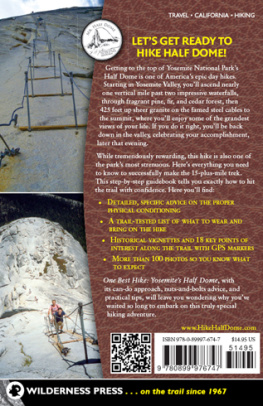C.P. James
DOME SIX
BOOK 1 OF THE CYTOCORP SAGA
For all who labor in anonymity.
Two particular scientific developments that come to bear on this series: antibiotic resistance and 3D bioprinting. If youre already familiar with these, keep trucking. If not, I thought you might appreciate a quick primer in laymans terms.
Antibiotic Resistance
Penicillin wasnt technically the first antibiotic. Advanced civilizations have used plants or molds with antibiotic properties for thousands of years, and it was a German doctor named Paul Ehrlich who discovered arsphenamine, the first modern antibiotic, as a treatment for syphilis. He was awarded the Nobel prize in 1908, and its interesting to note that he coined the phrase chemotherapy in reference to this treatment.
Of course, Alexander Fleming gets most of the credit. He (quite accidentally) discovered penicillin in 1928, but it wasnt actually introduced for widespread use until 1942. We take antibiotics for granted now, but chances are, someone in your family will remember a time before they were a thing. Until then, bacteria were the No. 1 cause of death worldwide.
But microorganisms like bacteria evolve and adapt like other living things. Over time, bacteria that are exposed to antibiotics but dont die from them become tougher. Those resistant traits get passed to the next generation of bacteria through natural selection, hence antibiotic resistance and so-called superbugs.
Dont panic just yet, but its very likely that the antibiotics weve relied upon to treat infections will eventually stop working altogether. When that happens, wed better have something to replace them or well return to the days when a relatively minor injury might kill you.
3D Bioprinting
By now, youre no doubt aware that 3D printing exists. You can use it to make just about anything you can envision, which is as exciting as it is scary. Youve probably seen the news stories about people who have 3D printed untraceable guns and such, but less insidious applications abound. The technology is already being used to make commercial products like shoes or to teach engineering and design.
But a close, and equally exciting/scary cousin of 3D printing is bioprinting, or biofabrication. This is the process of using so-called bioinks to literally print tissue from living cells, and its already here. In 2014, a company called Organovo announced that it has successfully printed viable liver tissue, which I suppose is especially good news for writers.
You can imagine the implications. In time, new organs, including skin, will be made on-demand, with a low probability of rejection. Ditto for parts, such as heart valves or limbs.
In May of 2019, researchers at the Medical Research Council Laboratory of Molecular Biology in Britain created a living organism with human-made DNA a.k.a. synthetic biology. It was just bacteria but imagine, for example, if you could infect someone with engineered bacteria that produced medicine as a by-product of metabolism.
This discovery has nothing to do with bioprinting, but if you could bioprint a different vessel for your synthetic DNA, you could design it to do whatever you needed it to. As bioprinting becomes more sophisticated, its not that big a leap to think that we will someday be able to design more complex, multicellular organisms.
One quick note on measurements. For all its faults, Cytocorps rise replaced imperial measurements with the metric system. As such, all measurements in The Cytocorp Saga are presented in metric terms. As a frame of reference, a meter is about 39 inches and a kilometer (aka a click) is about .6 miles.
So What?
As a science-fiction author, I like to speculate about what will happen if emerging technologies are taken to extremes. For this series, I considered what would happen if the end of the antibiotic age coincided with synthetic organisms coming into their own.
If antibiotics stop working, whatever comes next will only be available to those who can afford it. Everyone else will have to wait for a different solution, but if it lets them survive, theyll accept virtually any compromise it requires.
Historically, companies that provide the only viable solution to a widespread problem become very rich and powerful. The Cytocorp Saga is the story of how such a company might come to power, and what they might do with it.
C.P. James, January 2020Administrator
The head of the Authority at any given time, who is chief executive of the Dome. They are chosen by, and from, the Authority Council.
agora
The central, turf-covered area at the middle of the Dome where people gather for Epoch announcements and other ceremonial occasions. It is crisscrossed by walking paths and framed by the eight hydroponic Towers.
algorithms
A set of instructions used for data analysis. The Dome Project was designed for algorithms to make decisions based purely on data, logic, and forecasting so as to optimize every aspect of life.
Apex
The very top of the Domes roof, home to an array of sensors and cameras.
Apprentice
The status of a citizen who has received their initial Placement but not their final one, or, in some cases, a citizen who has been reassigned to a new role.
arc
The narrow streets that run concentrically around the Dome, generally used to get between the rads where the train stations are.
Authority
The governing body of the Dome. The Authority generally enforces both the Charter and decisions made by IDA. The Authority comprises Directorates that oversee the lives of all citizens.
Authority Council
The Administrator plus each of the six Directors. They meet on a weekly basis in a room adjacent to the Administrators office.
bioprinting
The process of constructing biological materials from Cytomatrix, chiefly Macros and Scrubbers.
Boneyard
The final resting place of junked Dome equipment sometimes raided for scraps by workers in the Stores.
Box
Slang for the Quietus Center, the building where Elders are sent to be terminated (Quietus) at age 75.
Burn
Slang term for the all-consuming drought that originally forced the Northern Migration in the mid 21st century. As hot, dry weather spread through the tropics, it eventually reached the southern United States and drove millions of people to start a new life in the Northern Cities. Epoch data indicates that it only continued its push north and is believed to be unsurvivable.
Cache
The Domes publicly accessible information repository. Once, the Dome had access to outside networks but the hardline was cut shortly after the Dome Project began because hackers supposedly were close to breaking in. The Cache is a snapshot of the internet from that time period, based purely on content its citizens had viewed to that point.
Charter
The Domes version of the US Constitution, the Charter outlines the rules and procedures that all citizens must follow.
CHIT
Citizen Health and Information Tag. This capsule-shaped device is embedded in the right forearm of newborns and is effectively the interface between citizens and IDA. In addition to their health information, it tracks their physical location so that access to certain areas is tightly controlled.
crawlers
Large rectangular platforms with chest-height railings that enable maintenance workers to perform inspections and repairs on the roof of the Dome. They travel up and down via channels in the Domes lattice structure.












